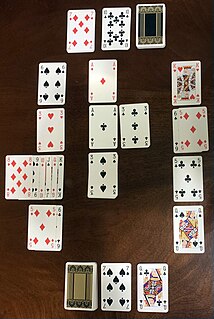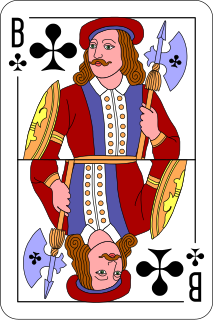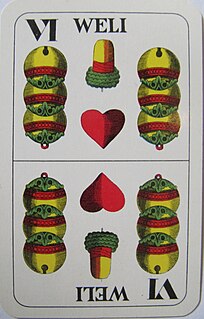Related Research Articles

Games of patience, or (card) solitaires as they are usually called in North America, have their own 'language' of specialised terms such as "building down", "packing", "foundations", "talon" and "tableau". Once learnt they are helpful in describing, succinctly and accurately, how the games are played. Patience games are usually for a single player, although a small number have been designed for two and, in rare cases, three or even four players. They are games of skill or chance or a combination of the two. There are three classes of patience grouped by object.

Cheat is a card game where the players aim to get rid of all of their cards. It is a game of deception, with cards being played face-down and players being permitted to lie about the cards they have played. A challenge is usually made by players calling out the name of the game, and the loser of a challenge has to pick up every card played so far. Cheat is classed as a party game. As with many card games, cheat has an oral tradition and so people are taught the game under different names.

Russian Bank, Crapette or Tunj, historically also called Wrangle, is a card game for two players from the patience family. It is played with two decks of 52 standard playing cards. The U.S. Playing Card Company, who first published its rules, called it "probably the best game for two players ever invented".
Elfern or Elfmandeln, is a very old, German and Austrian 6-card, no-trump, trick-and-draw game for two players using a 32-card, French-suited Piquet pack or German-suited Skat pack. The object is to win the majority of the 20 honours: the Ace, King, Queen, Jack and Ten in a Piquet pack or the Ace, King, Ober, Unter and Ten in a Skat pack. Elfern is at least 250 years old and a possible ancestor to the Marriage family of card games, yet it is still played by German children.

Gaigel is a card game from the Württemberg region of Germany and is traditionally played with Württemberg suited cards. It is a Swabian variant of Sechsundsechzig and may be played with 2, 3, 4 or 6 players. However, a significant difference from Sechsundsechzig and other related games like Bauernschnapsen is the use of a double card deck. The four-player game is usually called Kreuzgaigel. The game emerged in the early 19th century.

Tapp is a trick-taking, card game for 3 or 4 players using 36 French-suited cards that originated in the south German Kingdom of Württemberg. It is very old, being the French-suited offshoot of German Tarok played in that state. In its German-suited form as played in Württemberg, it is called Württemberg Tarock. It is one of a family of similar games that include Bavarian Tarock, the Austrian games of Bauerntarock and Dobbm, and the American games of Frog and Six-Bid Solo. Although probably first played in the early nineteenth century, the game of Tapp is still a local pastime in its native Württemberg, albeit in a greatly elaborated form.

German Rummy or Rommé is the most popular form of the worldwide game, Rummy, played in Austria and Germany. It is a game for 2 to 6 players and is played with two packs of French playing cards, each comprising 52 cards and 3 jokers. There are no partnerships. In Germany, the Germany Rummy Association is the umbrella organisation for local rummy clubs and organises national competitions. The game is often just known as Rommé in Germany and Rummy in Austria.

Solo 66 is a trick-taking, Ace-Ten, card game for five players in which a soloist always plays against the other four. It is based on the rules of Germany's national game, Skat, and is played with a French-suited Skat pack of 32 cards. Bidding is for the trump suit. Jacks are ranked within their respective suits and do not form additional trumps over and above the cards of the trump suit. Grupp describes it as "an entertaining game for a larger group."

Mistigri, historically Pamphile, is an old, French, trick-taking card game for three or four players that has elements reminiscent of poker. It is a member of the Rams family of games and, although it is a gambling game, often played for small stakes, it is also suitable as a party game or as a family game with children from the age of 12 upwards.

Kratzen is an Austrian card game for three to six players that is played for small stakes usually using a 33-card William Tell pack. It is a member of the Rams group of card games characterised by allowing players to drop out of the current game if they think they will be unable to win any tricks or a minimum number of tricks. The game is related to the Swiss Jass form, Chratze and has been described as "fun" to play.
Silesian Lottery, also called Card Lottery (Kartenlotterie), Card Tombola (Kartentombola), Großes Los, Grüne Wiese or Bullermännchen, is a simple, German, game of chance and gambling card game, that is played with two packs of 32 Bavarian-pattern or French-suited playing cards.

Blüchern is a simple gambling card game for any number of players that is played either with a pack of 52 French playing cards or with a pack of 32 French or German playing cards.
Zwanzig ab, 20 ab or simply Zwanzig is card game for four players. It is a member of the Rams family in which the key feature is that players may choose to drop out of the game if they believe their hand is not strong enough to take a minimum number of tricks. It appears to be a recent, internet-propagated variant of Schnalzen or Bohemian Watten. However, the latter has a natural card ranking, is played with double German cards and a Weli, has no exchanging and has a different scoring system. It is suitable for children from 8 upwards. It may be related from Fünf dazu! which is a simpler game described by Gööck in 1967 that has neither trumps nor the option to drop out.

Letzter Stich is a card game for 3 or 4 players in which the aim is solely to win the last trick. It originated in Germany and the names mean "last trick" respectively. It has been described as suitable for children, yet having a "surprising wealth of interesting game situations." It should not be confused with Letzter, a reverse game of greater complexity where the aim is to lose the last trick.

Voller Hund or Hund, possibly known in Austria as Hundern or Hundspiel, is a German card game that is suitable for children. It is named after the Eight of Leaves, the Dog, which used to depict a dog in old card packs. The equivalent card in a standard pack is the Eight of Spades.

Bettelmann or Tod und Leben is a simple, trick-taking card game for 2 players that is suitable for children. Bettelmann is of German origin and is mentioned as early as 1841. It closely resembles Battle.
Hundert is an Ace-Ten card game for 3 or more players that is suitable for children.

Pollack is a German card game for four players in two teams of two that resembles the Italian game of Tresette, the aim being to score as many points as possible by taking tricks containing point-scoring cards and by announcing certain hand combinations as bonuses. According to Gööck, new players quickly realise that there is quite a lot to it and only those who stay alert get opportunities to score. The game is named after a bonus for holding its three top cards: the Ten, Nine, and Ace of one suit.
Rabouge is an historical German card game for any number of players and played with French-suited cards. The aim is to discard one's cards as quickly as possible to a central pile. The game resembles Russian Bank patience for two, but is easier to play.

1001 is a point-trick card game of German origin for two players that is similar to Sixty-Six. It is known in German as Tausendundeins and Tausendeins ("1001") or Kiautschou. The winner is the first to 1001 points, hence the name. Hülsemann describes the game as "one of the most stimulating for two players", one that must be played "fast and freely".
